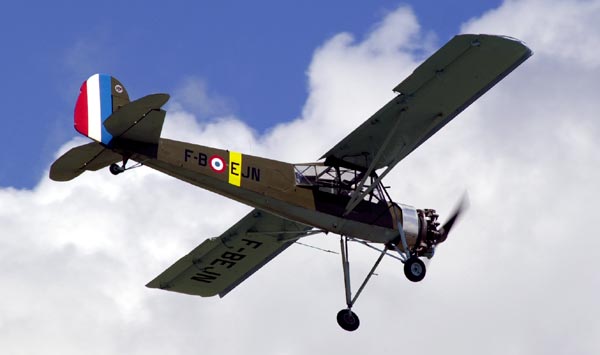Fieseler Fi 156
Storch ("Stork")
Variants/Other Names: Morane-Saulnier MS500
Criquet ("Locust"); Mraz K-65 Cap ("Stork"); See History
below for others.

(Photo source unknown. Please contact us if you deserve credit.)
History: The fabric-covered Storch
observation monoplane served the German Forces throughout World War Two wherever the
Germans saw combat. With ten times the life expectancy of the Bf 109 fighter, the Storch
("Stork") proved to be a rugged Short Take Off and Landing (STOL) airplane that
gained the respect of all its pilots.
The Storch was first flown in 1936. Using a fixed slat over the leading edge of the wing
and slotted camber-changing flaps along the trailing edge, the Storch achieved incredible
short take-off performance. In a light breeze the Storch could take off in just 200 feet
(60 meters) and land in about 66 feet (20 meters). It had a crew of three, and with
extensive windows surrounding the occupants, made an excellent observation and liaison
aircraft. Production for the German armed forces began with the Fi 156A-1.
The Fi 156C, which had the rear glazing raised to accommodate a
machine gun for defense, soon replaced the A-1. Other variants included a tropical version
with dust filters, an ambulance version carrying a single stretcher, and an enlarged
version (Fi 256) with seating for five built in limited numbers
in France between 1943 and 1944. Fieseler began building the Storch in Germany, but was
soon forced to move production to Morane-Saulnier in France (as the M.S.500
Criquet) and Mraz in Czechoslovakia (as the K-65 Cap).
This was done to make room for the BF 109 at the Fieseler plant.
The Fieseler Storch was the last dogfight victim of the
western front. Pilot Duanes Francies and his observer, Lieutenant William Martin, of the
5th US Army Division, spotted a Storch circling below them while looking for ground
targets in their Piper Cub. Diving on the Storch, the two men opened fire with their Colt
.45s and the plane spiraled to the ground. After a short gun battle, Francies and his
observer took the two Germans into custody. Lt. Martin was awarded the Air Medal for his
part in the fight, but Francies would have to wait until the story was reported in
Cornelius Ryan's book "The Last Battle," to finally be awarded the
Distinguished Flying Cross. The USAF was 22 years late. Apart from being the last
Luftwaffe plane lost in the west, this Storch was also the only enemy plane downed by
pistol fire during the war.
After the war Morane-Saulnier continued to produce the Storch as the M.S.500, and
Mraz continued to build the K-65 Cap. Over 2,900 Fi 156s were produced. Today,
approximately 30 Fi 156s and their brethren have survived in Europe and
North America, and only four are still capable of flying today.
Nicknames: None
Specifications (Fi 156C-2):
Engine: One 240-hp Argus As 10C-3, 8-cylinder inverted-V piston engine
Weight: Empty 2,050 lbs., Max
Takeoff 2,921 lbs.
Wing Span: 46ft. 9in.
Length: 32ft. 5.75in.
Height: 10ft. 0in.
Performance:
Maximum Speed:
109 mph
Cruising Speed:
81 mph
Ceiling: 15,090
ft.
Range: 239 miles
Armament: One rear-firing 7.93-mm
(0.31-inch) machine gun on pivot mount
Number Built: 2,900+
Number Still Airworthy: ~4
Links:
CAF Ghost Squadron -- Fi 156 Storch
John's Slepcev Storch Project
Ping's Storch Page
USAF Museum Storch

[Back to Warbird Alley's Main
Page]
All text and photos Copyright 2016 The
Doublestar Group, unless otherwise noted.
You may use this page for your own, non-commercial reference purposes only.
 |